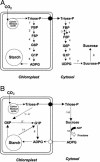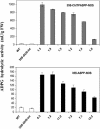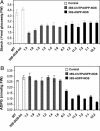Most of ADP x glucose linked to starch biosynthesis occurs outside the chloroplast in source leaves
- PMID: 15326306
- PMCID: PMC516520
- DOI: 10.1073/pnas.0402883101
Most of ADP x glucose linked to starch biosynthesis occurs outside the chloroplast in source leaves
Abstract
Sucrose and starch are end products of two segregated gluconeogenic pathways, and their production takes place in the cytosol and chloroplast of green leaves, respectively. According to this view, the plastidial ADP.glucose (ADPG) pyrophosphorylase (AGP) is the sole enzyme catalyzing the synthesis of the starch precursor molecule ADPG. However, a growing body of evidences indicates that starch formation involves the import of cytosolic ADPG to the chloroplast. This evidence is consistent with the idea that synthesis of the ADPG linked to starch biosynthesis takes place in the cytosol by means of sucrose synthase, whereas AGP channels the glucose units derived from the starch breakdown. To test this hypothesis, we first investigated the subcellular localization of ADPG. Toward this end, we constructed transgenic potato plants that expressed the ADPG-cleaving adenosine diphosphate sugar pyrophosphatase (ASPP) from Escherichia coli either in the chloroplast or in the cytosol. Source leaves from plants expressing ASPP in the chloroplast exhibited reduced starch and normal ADPG content as compared with control plants. Most importantly however, leaves from plants expressing ASPP in the cytosol showed a large reduction of the levels of both ADPG and starch, whereas hexose phosphates increased as compared with control plants. No pleiotropic changes in photosynthetic parameters and maximum catalytic activities of enzymes closely linked to starch and sucrose metabolism could be detected in the leaves expressing ASPP in the cytosol. The overall results show that, essentially similar to cereal endosperms, most of the ADPG linked to starch biosynthesis in source leaves occurs in the cytosol.
Copyright 2004 The National Academy of Sciencs of the USA
Figures



Similar articles
-
Plastidial localization of a potato 'Nudix' hydrolase of ADP-glucose linked to starch biosynthesis.Plant Cell Physiol. 2008 Nov;49(11):1734-46. doi: 10.1093/pcp/pcn145. Epub 2008 Sep 18. Plant Cell Physiol. 2008. PMID: 18801762
-
Sucrose synthase controls both intracellular ADP glucose levels and transitory starch biosynthesis in source leaves.Plant Cell Physiol. 2005 Aug;46(8):1366-76. doi: 10.1093/pcp/pci148. Epub 2005 Jun 11. Plant Cell Physiol. 2005. PMID: 15951568
-
Reappraisal of the currently prevailing model of starch biosynthesis in photosynthetic tissues: a proposal involving the cytosolic production of ADP-glucose by sucrose synthase and occurrence of cyclic turnover of starch in the chloroplast.Plant Cell Physiol. 2001 Dec;42(12):1311-20. doi: 10.1093/pcp/pce175. Plant Cell Physiol. 2001. PMID: 11773523 Review.
-
Enhancing sucrose synthase activity results in increased levels of starch and ADP-glucose in maize (Zea mays L.) seed endosperms.Plant Cell Physiol. 2013 Feb;54(2):282-94. doi: 10.1093/pcp/pcs180. Epub 2013 Jan 3. Plant Cell Physiol. 2013. PMID: 23292602
-
Starch metabolism in leaves.Acta Biochim Pol. 2008;55(3):435-45. Epub 2008 Sep 12. Acta Biochim Pol. 2008. PMID: 18787712 Review.
Cited by
-
Arabidopsis Responds to Alternaria alternata Volatiles by Triggering Plastid Phosphoglucose Isomerase-Independent Mechanisms.Plant Physiol. 2016 Nov;172(3):1989-2001. doi: 10.1104/pp.16.00945. Epub 2016 Sep 23. Plant Physiol. 2016. PMID: 27663407 Free PMC article.
-
Plastidic phosphoglucose isomerase is an important determinant of starch accumulation in mesophyll cells, growth, photosynthetic capacity, and biosynthesis of plastidic cytokinins in Arabidopsis.PLoS One. 2015 Mar 26;10(3):e0119641. doi: 10.1371/journal.pone.0119641. eCollection 2015. PLoS One. 2015. PMID: 25811607 Free PMC article.
-
Expression of the ggpPS gene for glucosylglycerol biosynthesis from Azotobacter vinelandii improves the salt tolerance of Arabidopsis thaliana.J Exp Bot. 2009;60(6):1679-89. doi: 10.1093/jxb/erp030. Epub 2009 Apr 10. J Exp Bot. 2009. PMID: 19363207 Free PMC article.
-
UDP-Sugar Producing Pyrophosphorylases: Distinct and Essential Enzymes With Overlapping Substrate Specificities, Providing de novo Precursors for Glycosylation Reactions.Front Plant Sci. 2019 Jan 4;9:1822. doi: 10.3389/fpls.2018.01822. eCollection 2018. Front Plant Sci. 2019. PMID: 30662444 Free PMC article. Review.
-
Genotype-dependent and heat-induced grain chalkiness in rice correlates with the expression patterns of starch biosynthesis genes.Plant Environ Interact. 2021 Jun 15;2(4):165-176. doi: 10.1002/pei3.10054. eCollection 2021 Aug. Plant Environ Interact. 2021. PMID: 37283703 Free PMC article.
References
-
- Recondo, E. & Leloir, L. F. (1963) Biochem. Biophys. Res. Commun. 6, 85-88. - PubMed
-
- Murata, T., Minamikawa, T. & Akazawa, T. (1963) Biochem. Biophys. Res. Commun. 6, 439-443.
-
- Stitt, M. & Quick, W. P. (1989) Physiol. Plantarum 77, 633-641.
Publication types
MeSH terms
Substances
LinkOut - more resources
Full Text Sources
Other Literature Sources

